The Female Integrated Treatment (FIT) Program
- An evidence-based approach designed to ensure that each participant has an individually tailored treatment plan and
- receives a full range of services to address their needs.
- The program will combine 3 psychology treatment programs, including
- The Residential Drug Abuse Program is for those who are eligible.
Women are twice as likely as men to experience PTSD, according to the World Health Organization.
- A woman’s chances of experiencing trauma are higher —
- 10% of women will experience PTSD versus 4% of men.
- “It’s tough to say there are sure symptoms of PTSD since no two people will have the same experience,” Pereau says.
DSM-V Revisions to Signs and Symptoms of PTSD
- In the most recent publication of the DSM, the DSM-V, PTSD symptoms are grouped into five different clusters.
- One or more symptoms are required from each of these clusters in order for a patient to receive a full diagnosis.
Stressor– (one required)
- The person was exposed to injury or severe illness that was life-threatening, which includes actual or threatened injury or violence. This may include at least one of the following:
- Direct exposure to the trauma
- Witnessing a trauma
- Exposure to trauma by being a first responder, such as a police, firefighter, medic, or crisis counselor
- Learning that someone close to you experienced the trauma
Intrusion Symptoms(one required) –
- The person who was exposed to trauma then re-experiences the trauma in one or more ways, including:
-
- Flashbacks
- Nightmares
- Distressing and intense memories
- Distress or physical reactions after being exposed to reminders, known as “triggers”
Unpleasant Changes to Mood or Thoughts(two required) –
-
- Blaming self or others for the trauma
- Decreased interest in things that were once enjoyable
- Negative feelings about self and the world
- Inability to remember the trauma clearly
- Difficulty feeling positive
- Feelings of isolation
- Negative affect, and difficulty feeling positive
Avoidance(one required) –
- This occurs when a person tries to avoid all reminders of the trauma, including:
-
- Avoiding external reminders of what happened
- Avoiding trauma-related thoughts or emotions, sometimes through the use of drugs or alcohol
Changes in Reactivity(two required) –
- This occurs when a person becomes more easily startled and reacts to frightful experiences more fully, including symptoms of:
-
- Aggression or irritability
- Hypervigilance and hyper-awareness
- Difficulty concentrating
- Difficulty sleeping
- Heightened startle response
- Engaging in destructive or risky behavior
- Difficulty sleeping or staying asleep
All of these symptoms must have persisted for at least one month, and they must be causing distress or functional impairment of some kind.
These symptoms must not be related to any substance use, illness, or medications.


